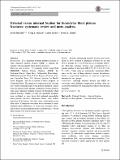| dc.contributor.author | Metcalfe, David | en_US |
| dc.contributor.author | Hickson, Craig J. | en_US |
| dc.contributor.author | McKee, Lesley | en_US |
| dc.contributor.author | Griffin, Xavier L. | en_US |
| dc.date.accessioned | 2015-12-04T18:13:09Z | |
| dc.date.issued | 2015 | en_US |
| dc.identifier.citation | Metcalfe, David, Craig J. Hickson, Lesley McKee, and Xavier L. Griffin. 2015. “External versus internal fixation for bicondylar tibial plateau fractures: systematic review and meta-analysis.” Journal of Orthopaedics and Traumatology : Official Journal of the Italian Society of Orthopaedics and Traumatology 16 (4): 275-285. doi:10.1007/s10195-015-0372-9. http://dx.doi.org/10.1007/s10195-015-0372-9. | en |
| dc.identifier.issn | 1590-9921 | en |
| dc.identifier.uri | http://nrs.harvard.edu/urn-3:HUL.InstRepos:23845135 | |
| dc.description.abstract | Background: It is uncertain whether external fixation or open reduction internal fixation (ORIF) is optimal for patients with bicondylar tibial plateau fractures. Materials and methods A systematic review using Ovid MEDLINE, Embase Classic, Embase, AMED, the Cochrane Library, Open Grey, Orthopaedic Proceedings, WHO International Clinical Trials Registry Platform, Current Controlled Trials, US National Institute for Health Trials Registry, and the Cochrane Central Register of Controlled Trials. The search was conducted on 3rd October 2014 and no language limits were applied. Inclusion criteria were all clinical study designs comparing external fixation with open reduction internal fixation of bicondylar tibial plateau fractures. Studies of only one treatment modality were excluded, as were those that included unicondylar tibial plateau fractures. Treatment effects from studies reporting dichotomous outcomes were summarised using odds ratios. Continuous outcomes were converted to standardized mean differences to assess the treatment effect, and inverse variance methods used to combine data. A fixed effect model was used for meta-analyses. Results: Patients undergoing external fixation were more likely to have returned to preinjury activities by six and twelve months (P = 0.030) but not at 24 months follow-up. However, external fixation was complicated by a greater number of infections (OR 2.59, 95 % CI 1.25–5.36, P = 0.01). There were no statistically significant differences in the rates of deep infection, venous thromboembolism, compartment syndrome, or need for re-operation between the two groups. Conclusion: Although external fixation and ORIF are associated with different complication profiles, both are acceptable strategies for managing bicondylar tibial plateau fractures. Level of evidence II. | en |
| dc.language.iso | en_US | en |
| dc.publisher | Springer International Publishing | en |
| dc.relation.isversionof | doi:10.1007/s10195-015-0372-9 | en |
| dc.relation.hasversion | http://www.ncbi.nlm.nih.gov/pmc/articles/PMC4633424/pdf/ | en |
| dash.license | LAA | en_US |
| dc.subject | External fixation | en |
| dc.subject | Internal fixation | en |
| dc.subject | Bicondylar tibial plateau | en |
| dc.subject | Proximal tibial fracture | en |
| dc.title | External versus internal fixation for bicondylar tibial plateau fractures: systematic review and meta-analysis | en |
| dc.type | Journal Article | en_US |
| dc.description.version | Version of Record | en |
| dc.relation.journal | Journal of Orthopaedics and Traumatology : Official Journal of the Italian Society of Orthopaedics and Traumatology | en |
| dash.depositing.author | Metcalfe, David | en_US |
| dc.date.available | 2015-12-04T18:13:09Z | |
| dc.identifier.doi | 10.1007/s10195-015-0372-9 | * |
| dash.contributor.affiliated | Metcalfe, David | |


